Management Notes are prepared by staff from the College of Agriculture, Food and Rural Enterprise (CAFRE). Questions and comments are welcome to allow CAFRE to address the issues that are important to you. Please contact the author directly. CAFRE is a college within the Department of Agriculture and Rural Development (DARD).

Dairying
Slurry and manure import and export records
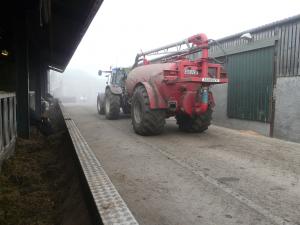
Further information, a sample record sheet, details of how to submit organic manure export records, together with information on exporting manure to The Republic of Ireland, can be found in the ‘Nitrates Action Programme (NAP) 2015-2018 and Phosphorus Regulations Guidance’ booklet. The publication is also available on the DARD website (https://www.dardni.gov.uk/publications/2015-2018-nitrates-action-programme-and-phosphorus-regulations-and-associated-documents) and the NIEA website (https://www.doeni.gov.uk/publications/nitrates-action-programme-2015-2018-and-phosphorus-regulations-guidance-booklet).
Changes to the N and P content of manures
Another change in the NAP, also effective from 1 January 2015, is the revision of some nutrient values. These include the nitrogen and phosphorus contents of cattle and pig slurry, as well as some types of farmyard and poultry manure.
The nitrogen content of cattle slurry is now 2.6 kg per cubic metre. Previous figures were 3.0 kg nitrogen per cubic metre for dairy cattle slurry and 2.3 kg per cubic metre for beef cattle slurry.
As the N content of dairy cattle slurry is now less this means you need to export a higher volume of slurry to achieve a N loading under the limit of 170 kg N per hectare, assuming livestock numbers and land area are similar to previous years.
If you rely on manure exports to stay under the maximum livestock manure nitrogen loading limit of 170 kg per hectare, the advice is to recalculate the nitrogen loading for your farm and determine the quantity of slurry/manure that needs to be exported.
Getting the cow back in calf!
Breeding is well underway. All cows six weeks calved should have displayed a heat and are past their ‘voluntary waiting period’. Cows seen to have been in heat after this should be bred and a record of the service made on farm software. Assess your breeding efficiency by working out the submission rate for the last three weeks. That is, how many cows, that completed their ‘voluntary waiting period’ three weeks ago, are served? This answers the question, how many cows did I serve that were eligible to be served in the last 21 days - which should be all of them! If not, there is a problem with heat detection on the farm.
Tackling digital dermatitis
Routine foot bathing after four consecutive milkings each week is the most practical way to control digital dermatitis. Without regular foot bathing the incidence of digital dermatitis will increase weekly during the winter. Ideally use a double foot bath to wash and treat feet. The wash bath is needed to remove dung that reduces the effectiveness of the chemical in the treatment bath. If you do not have enough space to fit in two baths, hose wash the feet of cows before they leave the parlour. As cows need to take at least three strides through the treatment bath it should be 3 m long and filled to a depth of 10 cm.
Typical January performance
How does your farm compare with the typical performance from the Co Armagh farms I work with:
| Average daily milk yield | 23.5 litres per cow |
|---|---|
| Average daily concentrate fed | 8 kilos per cow |
| Average daily milk from forage | 5.7 litres per cow |
| Average daily concentrate feed rate | 0.34 kilos per litre |
Feed efficiency is critical; target concentrate feeding to those cows that need it most.
If you require information on any of these topics, contact your local CAFRE Dairying Development Adviser.
Prepared by: Michael Garvey
E-mail: michael.garvey@dardni.gov.uk
Telephone: 028 3752 9054
Beef and sheep

Beef
Prepare for calving
Many suckler farms are now preparing for the onset of spring calving. Good preparation is vital, hopefully reducing calf mortality, saving labour and lowering stress on both cows and farmers.
One calving pen for every 20 cows is needed as a general guideline. This figure can be increased or decreased depending on how tight you expect your calving spread to be and how long you want the cow and calf to remain in the pen. Minimum pen size is 3.6 m x 3.6 m but ideally it should be above 4 m x 4 m. Thoroughly clean and disinfect pens beforehand to minimise the spread of disease. When calving starts use straw bedding in abundance and have all equipment in place. At a minimum include the following:
- long arm gloves
- calving and head ropes
- iodine solution
- veterinary lubricant
- calving aid
Calving should be planned as far as practically possible. An estimated calving date can be predicted using AI/breeding/scanning records and gestation lengths, but nothing replaces close observation and experience of visual assessment. Ideally move cows to bedded open sheds 10-14 days before calving to prevent slipping or injuries on slats. A change of housing too close to calving can delay some cows.
Safety is paramount as cows can be more aggressive at calving. Have an escape route planned and make sure gates and barriers are strong and fit for purpose.
Sheep
Diminishing grass supplies
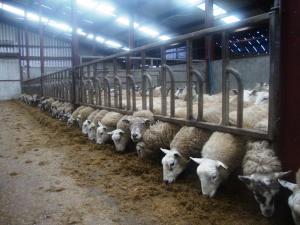
Ventilation: For ventilation to be effective, there should be a free flow of fresh air between the sides/eaves above sheep level (to avoid draughts) and the outlets. As many sheep houses have other uses during the year, make sure clear the inlets are clear of dust and debris, especially in ventilated tin.
Hygiene: thoroughly power wash and disinfect all sheep housing, including pen divisions, before housing. Iodine based disinfectants work well.
Floor space: unclipped lowland ewes on slats require a space of 1.0 square metre per ewe. This reduces to 0.9 square metres per ewe for unclipped hill breeds and clipped lowland ewes. Straw bedded ewes require 1.1 to 1.4 square metres.
Feed space: when meal feeding heavily pregnant ewes, provide 420-475 mm (16-19 inches) trough space per ewe to allow them all to eat at the one time. With silage fed ad lib allow a minimum of 200 mm (8 inches) feeding space per ewe.
Lambing pens should be 1.83 m x 1.22 m (6 feet x 4 feet) with one lambing pen for every 8 to 10 ewes. Ewes scanned and/or keel marked at tupping can be split according to lambing date.
The performance of lambs at grass suffers during periods of heavy rainfall due to poor grazing activity, utilisation and a reduction in grass dry matter. Concentrate feeding levels of 0.5-0.8 kg may be needed just to cover maintenance. This will need to be increased to improve performance.
Exporting/importing organic manures
As stated in the dairy notes, records of exports of all organic manures must be submitted annually to NIEA by 31 January for the previous calendar year. Exporting may not be as common in the beef and sheep sector as in the dairy sector, but it is important if you import slurry to stay below the 170 kg nitrogen per hectare limit. Do your calculations and keep records of quantities of slurry imported and from whom.
Prepared by: Darryl Boyd
E-mail: darryl.boyd@dardni.gov.uk
Telephone: 028 9034 0957
Horticulture
Protecting horticultural crops against cold weather
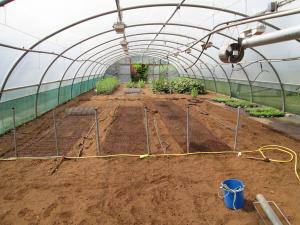
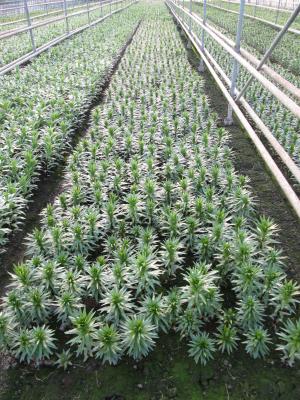
The extent of winter damage can vary according to location of an individual nursery or farm and between regions. Minimise the risk of damage to your horticultural crops and equipment by:
- using appropriate insulation and frost protection measures
- bringing plants under protected structures and using wind breaks
- covering plants with protective fleece materials
- careful watering of plants, to avoid overwatering
- draining out irrigation systems and equipment before cold weather sets in
- setting thermostats to give a regime -1.0 degree to +5.0 degrees centigrade
Soil sampling of glasshouse soils
For protected crop growers the New Year is an appropriate time to take a glasshouse soil sample before new season crops are planted. Annual soil sampling is important for soil grown glasshouse crops to check pH, nutrient and Electrical Conductivity (EC) levels. Sample outdoor areas every four years but always sample new ground.
When taking a soil sample use a soil auger to take cores from the root zone, normally 150 mm deep. Take cores from all areas of the glasshouse, normally in a 'W' pattern. Sample separately any uncharacteristic areas, for example workstations or entrances. Remove any crop debris or plant material in the sample. Place the soil cores into a clear plastic bag with name, date, name of crop and greenhouse number. Samples should be 500 g in weight otherwise it may be rejected. Store at a cool temperature before posting to laboratory for analysis.
The glasshouse soil analysis will state nutrient levels of nitrogen (ammonium and nitrate), phosphorus, potassium and magnesium as an index. Optimum nutrient levels will vary according to the crop. For cut flower crops a target pH of 6.5 will ensure the maximum availability of nutrients for plant uptake. If the analysis states a high EC level ('salts'), for example above Index 3 for cut flower crops, remediation will be required before planting to prevent crop losses.
Before selecting a laboratory to carry out the analysis, check if the cost includes interpretation and length of time to receive results. Contact CAFRE's Cut Flower Adviser for guidance on taking soil samples or interpretation for cut flower crops.
Prepared by: Kieran Lavelle
E-mail : kieran.lavelle@dardni.gov.uk
Telephone: 028 3752 9060
Information Technology
Running your business using a tablet rather than a PC?
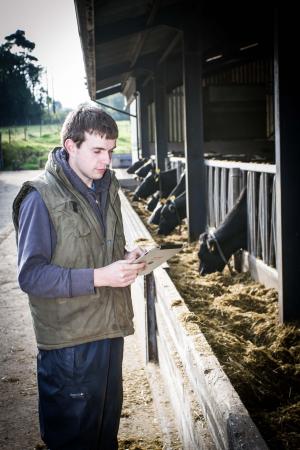
Where do I keep my data?
You wouldn’t consider purchasing a computer with 64 GB or less storage space. For most tablets this is all you get. If you have even a modest collection of files, including photos or videos, a tablet will not provide sufficient storage space. Technologies such as Cloud Storage and Network Attached Storage (NAS) have made it easier to manage large collections of data. However farming businesses need a PC based system with about 1000 GB (1TB) of storage to manage farm data now and into the future.
Surfing the net? Internet browsers are not all the same!
Small, light, always on, easy to pick up and set down; for the majority of the time a tablet is an ideal tool to surf the net. You may notice that not all websites work well on all devices. Sometimes the text, images or buttons are too small and at other times you will see a message telling you “Content cannot be displayed on your device”. Visiting a site for the first time on a tablet or attempting to use an online service such as APHIS Online can be a frustrating experience, particularly if you are familiar with using the website on a PC. Browsers on tablets are different to the browser on your PC. All websites are designed to function correctly on a PC browser (usually the latest version of Internet Explorer), and if it works on your tablet, it can be as much by good chance as by design. Thankfully many website designers are overcoming this problem by developing mobile versions of their websites or apps, such as APHIS Mobile, designed to look and function correctly on a mobile device. As you cannot guarantee a website has been designed to be used on a tablet, you will still need space for a PC in your office.
Keyboards, printing and processing power – there is still life in the PC yet!
When you need to sit down and do work that includes typing a lengthy email, printing out your MC2’s when moving cattle or fixing a few blemishes on photos of your best animals, it is best to do this at a computer with a full-sized keyboard and screen, your printer connected and enough processing power to do all three at the same time if necessary.
Tablets don’t have the best screen size, connection options or processing power when compared to a PC.
Tablets have a role as a secondary device, useful for casual surfing, checking emails and viewing photos or movies, but if you wish to run your business effectively you will need to hold on to your PC for a little while longer.
Prepared by: Ronan Coll
E-mail : ronan.coll@dardni.gov.uk
Telephone: 028 9442 6865
Notes to editors:
All media enquiries to DARD Press Office, pressoffice.group@dardni.gov.uk or tel: 028 9052 4619
Latest news
- DAERA Minister previews Balmoral Show 15 May 2024
- Muir opens £3million Peatland Challenge Fund Competition 15 May 2024
- Minister Muir sets out his priorities for the agri-food sector 14 May 2024
- DAERA at Balmoral Show 14 May 2024
